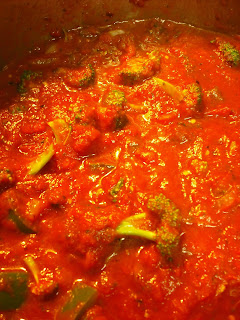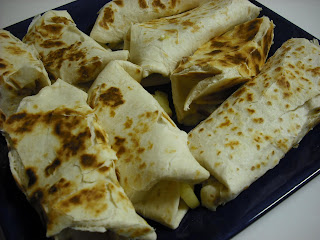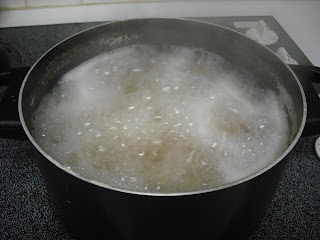
My Nana. She's 91. Born in Italy, I think outside Rome. Her father was a scholar, then a coal miner. One of her sisters died in the flu epidemic in 1918; she still has two brothers living, one older, one younger.
My Nana has lived on Long Island (good lord, it has its own website!) for half a century or more, in the same house facing the neighborhood school. She had three children after the war: my aunt Irene, my father, and my uncle Rich. When my father was 17 he and my mother, the 16-year-old daughter of a local Irish family, made me, then relinquished me to my adoptive parents. Two years later, when my bioparents were legal, they married and then had five children: Chris, Missy, Tom, John, and Tracey. We found each other ten years ago. Which is when I met my Nana, who filled her house with her relatives so that I could meet them all.
This is a nice story, and I'm betting you think that what's about to follow is her recipe for red gravy. Actually, it's sort of my sister Missy's recipe, only not quite that either. And maybe she got it from our Nana, I don't know. All I know is that one day I was visiting the coast and Missy said, let's make spaghetti sauce. And I blinked and said, okay, and then we were shopping, and then she was dumping things in a pot, and all of a sudden, blammo. My whole spaghetti sauce nightmare of a childhood ended. Ended, I say. Blammo.
Because as is probably clear to you from my other posts, my mother, bless her heart, was a modern cook. Packages. Pre-made stuff. If it came in a box or a can it was way superior to the raw, naked, whole stuff. I don't blame her. She's a product of her generation, as I am of mine. Thus, on the issue of red sauce she was multiply screwed: she didn't have the ethnic, class, or more generally cultural impetus to make her own. Her idea of getting spaghetti sauce was--go to A&P. Find Ragu. Buy Ragu. Heat Ragu with browned ground beef. Serve over spaghetti noodles. Side salad of iceberg lettuce, pallid tomato, carrot dimes, either Ranch or Good Seasons Italian.
This isn't Ragu. Doesn't have fifty weird ingredients, preservatives, all that sugar. It takes almost no time to fix.
As I've written it, this makes maybe three quarts of sauce, enough for two lasagnas and a little more. Decrease as necessary for your purposes.
Here's what you need:
Stock pot
olive oil
crushed garlic
oregano
basil
red pepper flakes and/or jalapeno mash
vegetables (here, it's onions, green peppers, and broccoli, though just about any sort will do)
Three large (32 oz) cans of crushed tomatoes
one small can of tomato paste
opt. med can of diced tomatoes
possibly a TBSP of sugar
possibly a little salt
Chop all your vegetables up. Set aside onions and peppers, since they'll go in first. But you can glop the rest together.
Open the cans. If you're using diced tomatoes, drain them only. Don't drain the others (you can't actually, but I didn't want you to try).
In the stock pot, heat up enough oil just to cover the bottom. I'd say about 4-5 TBSP max. Use med heat.
When you can smell the oil, or when it starts to shimmer, drop in a heaping spoon of garlic, a handful (maybe 3 TBSP) of oregano, half that of basil (so maybe a TBSP and a half), and some red pepper flakes or jalapeno mash.
Saute these in the oil for just a minute. Don't burn the garlic. This is easy to do, so err on the side of undercooking.
Add onions, peppers, celery, any veg that's there just for flavor. Saute until just limp, stirring pretty constantly.
When the onions are translucent, or the other vegetables are just a little soft, add the tomatoes.
Stir. Turn the heat to low. Cook uncovered for about five minutes, until the tomatoes are simmering. Taste.
It's important to taste at this point because your tomatoes might be very acid. If they taste like can, or sort of bitter, you'll need to add the sugar. This happens unpredictably, so you have to taste. Add salt at this point, too, if you feel you need it. I almost never feel I do.
When the tomatoes taste right to you, add the rest of the veg and about a third cup of wine. I generally just dump, about two glugs.
Bring to a boil over low-med heat (to keep you from having red sauce popping all over your kitchen). Taste, adjust for bitterness -- more sugar -- or for richness -- more wine. Let simmer until the vegetables are just cooked through.
If the sauce looks too thin, add more paste or just let it cook down for a while. This will overcook the vegetables, however, so unless that's okay with you, use the paste to thicken.
[This is a picture of the sauce boiling. I thought it was really neat: a still of motion. Also, the sauce launched a giant blob of red stuff into the atmosphere; it landed on my arm, where I licked it off like Yukon Cornelius licks his pick.]
There you go.












































